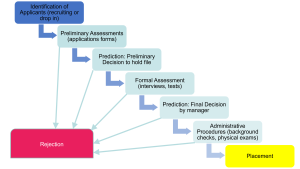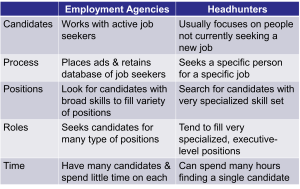5-1: Recruitment
 Have you ever wondered how companies like Google sift through millions of job applications to find their next superstar employee? Or maybe you’ve been on the other side, nervously waiting to hear back after what felt like an endless interview process. Welcome to the fascinating world of personnel selection — the systematic process organizations use to identify and hire the best candidates for their open positions.
Have you ever wondered how companies like Google sift through millions of job applications to find their next superstar employee? Or maybe you’ve been on the other side, nervously waiting to hear back after what felt like an endless interview process. Welcome to the fascinating world of personnel selection — the systematic process organizations use to identify and hire the best candidates for their open positions.

But here’s the thing — personnel selection doesn’t exist in isolation. It’s part of a much bigger picture that starts with recruiting and screening, moves through the actual hiring decision, and then continues with training and socialization once someone joins the organization. After that, you’re dealing with ongoing issues of job satisfaction, performance, rewards, and motivation. Even how the organization is designed — both psychologically and physically — can either limit or enhance people’s productive efforts and emotions. It’s like a domino effect where each piece influences the next.
Here’s something that might blow your mind: hiring the wrong person can cost an organization anywhere from 30% to 150% of that person’s annual salary. We’re talking about recruitment costs, training expenses, lost productivity, and eventually having to start the whole process over again. But flip that coin, and hiring the right person? That’s pure gold — they can drive innovation, boost entire team performance, and literally transform an organization’s future.
Think about your own experiences applying for jobs. You’ve probably filled out those seemingly endless applications, taken online tests that made you question your sanity, survived phone screenings where you tried to sound professional while your cat knocked things off your desk, and sat through interviews where you wondered if your answers made any sense. Each of these steps wasn’t random torture — they’re all part of a carefully designed system trying to answer one crucial question: will you succeed if we hire you?
What makes this field absolutely fascinating is how it brings together psychology, statistics, law, and business strategy all in one place. Organizations are constantly juggling competing priorities: they need to be selective enough to get amazing employees, but efficient enough to actually fill positions before their competitors do. They have to navigate complex legal requirements while still identifying the best talent. And they’re essentially trying to predict human behavior and performance — which, let’s be honest, is about as predictable as the weather sometimes.
But here’s why you should care about this beyond just getting your next job: whether you become a manager, start your own business, or work in HR, you’re going to be involved in hiring decisions. Understanding the science behind personnel selection is like having superpowers for spotting talent, avoiding expensive hiring mistakes, and building teams that actually work well together. It’s the difference between throwing darts blindfolded and having a roadmap to success.
The Recruitment Process
Personnel selection doesn’t just happen out of nowhere — it’s part of a much bigger talent management puzzle that starts with attracting people to your organization and ends with helping new hires actually succeed once they’re on board. Picture it like a funnel: you start with potentially thousands of people who might want to work for you, and through a series of steps, you narrow it down to the handful you actually hire.
The whole process kicks off with recruitment — which is basically marketing your organization and open positions to get qualified people interested in applying. There’s an old saying in HR: “you can’t hire people who don’t apply,” and it’s absolutely true. You could have the most scientifically perfect selection system in the world, but if great candidates never hear about your openings, you’re stuck choosing from whoever happens to stumble across your job posting.
Internal vs. External Recruitment
Now, you’ve got two main routes for finding people: looking inside your organization or casting your net into the wider world.
Internal recruitment is like shopping in your own closet — you’re promoting or transferring people who already work for you. This approach has some pretty sweet advantages: these folks already know how your organization works, they’ve proven they can succeed in your environment, and promoting from within makes everyone else more likely to stick around because they see a future for themselves. Plus, you actually know how these people perform in real life, not just how they interview.
But here’s the catch — every time you promote someone internally, you create another empty spot that needs to be filled. It’s like a game of musical chairs that never ends. And sometimes you need fresh blood, new perspectives, or specialized skills that just don’t exist in your current workforce.
External recruitment opens up the whole world of talent to you. You can tap into specialized expertise, bring in diverse perspectives that challenge the status quo, and find innovative thinkers who might revolutionize how you do business. The downside? These people are essentially strangers — you’re making educated guesses about how they’ll actually perform in your specific environment based on limited interactions.

Modern Recruitment Strategies
Today’s recruitment game has evolved way beyond posting jobs in newspaper classified sections (do those even exist anymore?). Organizations now use everything from sophisticated job boards and social media campaigns to campus recruiting programs and employee referral systems. And here’s something interesting: research shows that different recruitment methods attract different types of people, and how you write and advertise your job posting significantly impacts both how many people apply and the quality of those applicants (Kaplan, Aamodt, & Wilk, 1991).
Recent research has emphasized the importance of strategic recruitment that aligns with organizational characteristics, goals, and firm strategy (Breaugh, 2022). This approach recognizes that effective recruitment requires consideration of multiple levels of analysis – individual, team, and organizational – and connects recruitment practices across these levels to achieve better outcomes.
Employee Referral Programs
Employee referral programs have become particularly fascinating. About 50% of private organizations now have formal programs where they actually pay employees for successful referrals, and roughly 30% of all new hires come through these programs (Pomeroy, 2005). Why do they work so well? Think about it — if you’re a solid employee, you probably hang out with other solid people. It’s like social networking for talent acquisition, and it often produces candidates who are already somewhat familiar with your company culture through their connections.
Interestingly, only about 1% of public organizations like state and city governments have formal referral programs, though they’re sometimes used to encourage minority recruitment for positions like police officers and firefighters (Pomeroy, 2005). Some companies get creative with their referral incentives — one software company ran a campaign where employees whose referrals resulted in interviews were entered in a raffle for prizes including a TV, five cases of beer, 36 Baby Ruth bars, and a hammock. Talk about knowing your audience!
Job Fairs
You might also encounter job fairs in your career search, though opinions on their effectiveness vary widely. According to some career experts, job fairs can be largely a waste of time because companies often send junior HR representatives to collect resumes or direct people to websites — something you could accomplish more efficiently online. However, they can provide networking opportunities and help you get a feel for company culture if you approach them strategically.
Media Attributions
- Recruitment © Unknown is licensed under a Public Domain license
- The Selection Process © Jay Brown
- Employment Agencies vs. Headhunters
